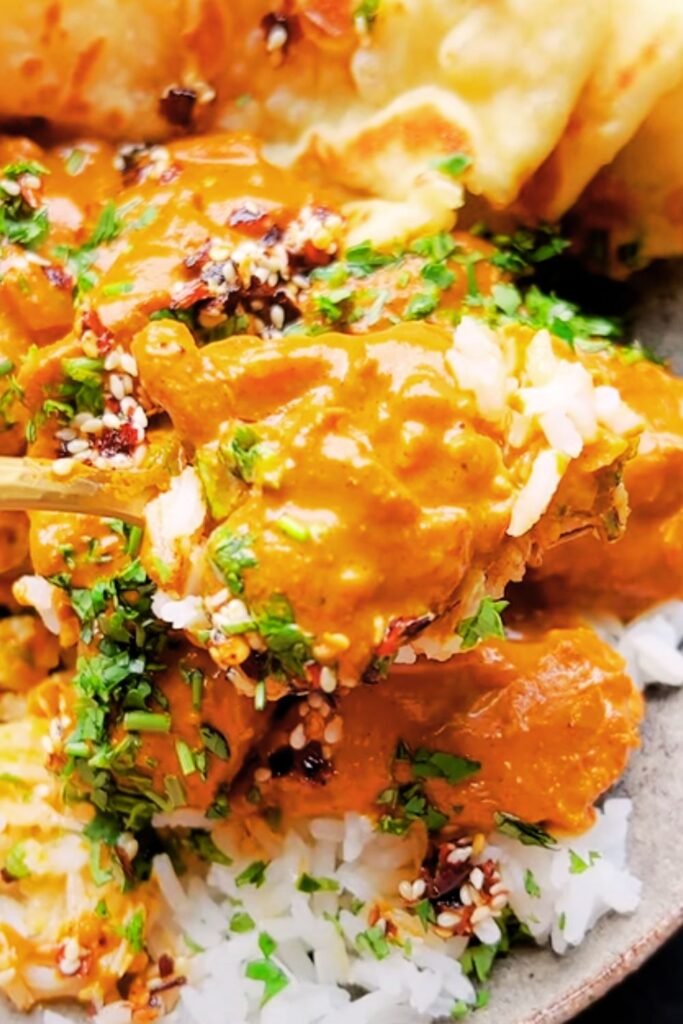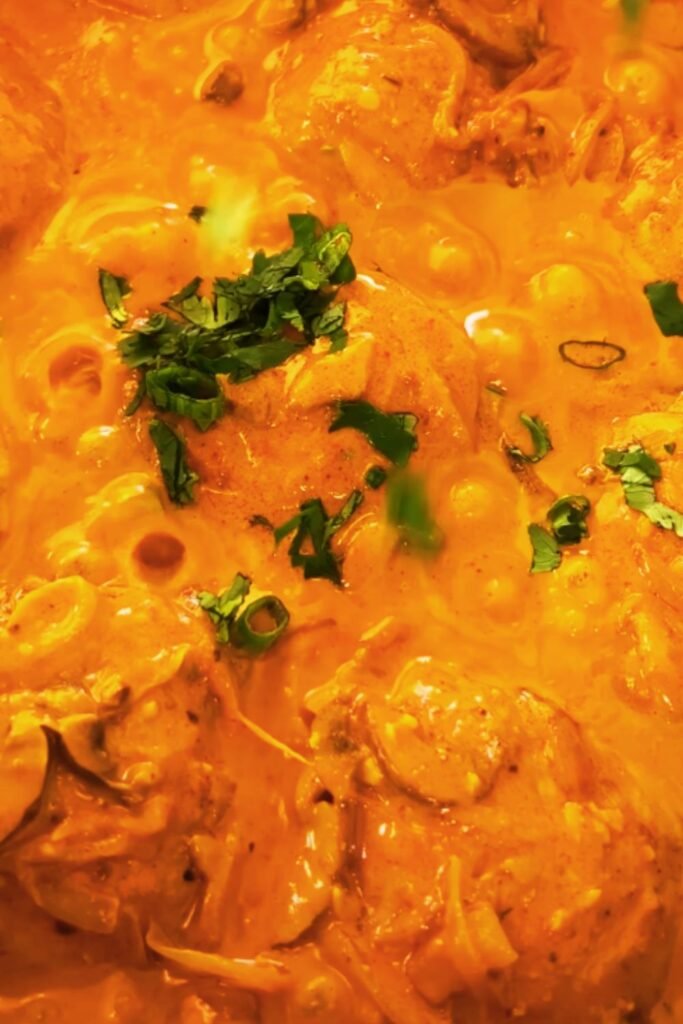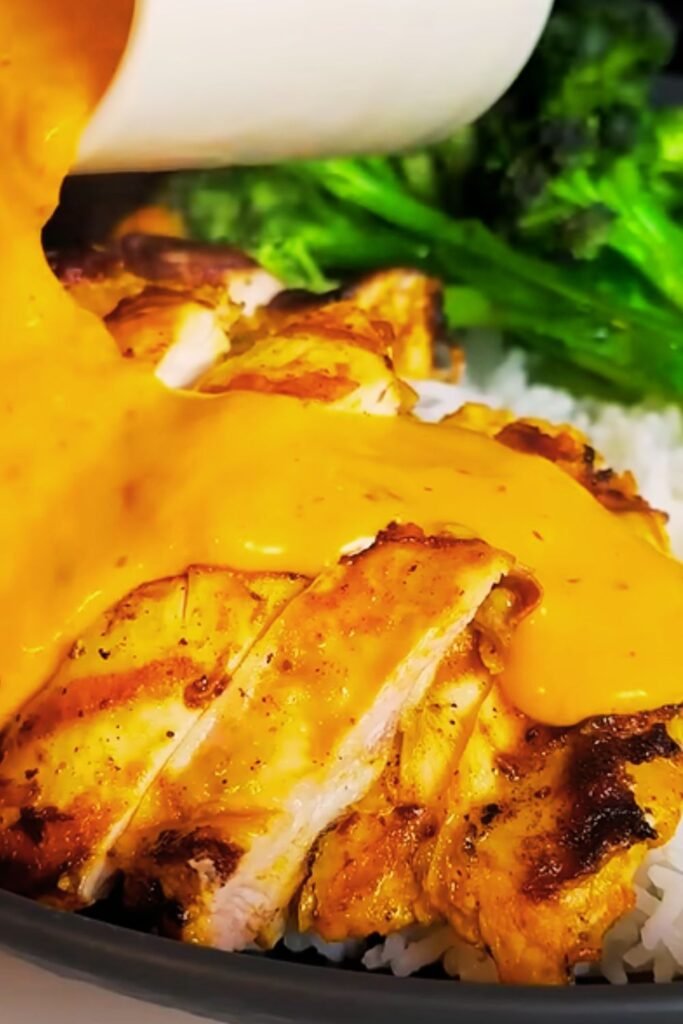There’s something magical about walking into your home after a long day and being greeted by the intoxicating aromas of Indian spices slowly simmering away. That’s exactly the experience I want to share with you today through this ridiculously delicious Crockpot Creamy Coconut Chicken Tikka Masala recipe.
As someone who has spent countless hours perfecting this dish, I can tell you that this isn’t just another slow cooker recipe—it’s a transformation of your kitchen into an aromatic Indian restaurant. The beauty of this dish lies in its complexity of flavors achieved through minimal effort. The slow cooker does all the heavy lifting while you go about your day.
What makes this version special is the addition of coconut milk, which creates a silky, creamy sauce that perfectly balances the warming spices. Whether you’re new to Indian cooking or a seasoned pro looking for convenience without sacrificing authenticity, this recipe hits all the right notes.
What Makes This Tikka Masala Special?
Traditional tikka masala typically involves marinating chicken in yogurt and spices, grilling it in a tandoor oven, and then simmering it in a rich tomato-based sauce. My crockpot version maintains those authentic flavors while simplifying the process to fit our busy lives.
Here’s what makes this recipe a standout:
- Dual Cooking Process: We’ll briefly sauté the aromatics before slow cooking to develop deeper flavor profiles
- Balanced Spice Blend: A carefully calibrated mixture of warming spices that provides depth without overwhelming heat
- Coconut Creaminess: The addition of coconut milk brings a subtle sweetness and velvety texture
- Make-Ahead Friendly: Tastes even better the next day as flavors continue to meld
- Freezer Compatible: Perfect for meal prep and future easy dinners
Ingredients You’ll Need

For the Marinade:
- 2 pounds boneless, skinless chicken thighs, cut into 1-inch pieces
- 1 cup plain Greek yogurt (full-fat works best)
- 2 tablespoons fresh lemon juice
- 3 cloves garlic, minced
- 1 tablespoon grated fresh ginger
- 2 teaspoons garam masala
- 1 teaspoon ground turmeric
- 1 teaspoon ground cumin
- 1 teaspoon kosher salt
- 1/2 teaspoon ground coriander
For the Sauce:
- 2 tablespoons ghee (or unsalted butter)
- 1 large yellow onion, finely diced
- 4 cloves garlic, minced
- 1 tablespoon grated fresh ginger
- 1 tablespoon tomato paste
- 2 teaspoons garam masala
- 2 teaspoons paprika (sweet, not smoked)
- 1 teaspoon ground cumin
- 1 teaspoon ground coriander
- 1/2 teaspoon ground turmeric
- 1/4 teaspoon cayenne pepper (adjust to taste)
- 1 cinnamon stick
- 2 cardamom pods, lightly crushed
- 1 can (28 ounces) crushed tomatoes
- 1 can (14 ounces) full-fat coconut milk
- 2 tablespoons brown sugar
- 1 1/2 teaspoons kosher salt (adjust to taste)
For Finishing:
- 1/2 cup heavy cream
- 1/4 cup chopped fresh cilantro, plus more for garnish
- 1 tablespoon fresh lemon juice
- Steamed basmati rice, for serving
- Warm naan bread, for serving
Equipment Needed
- 6-quart slow cooker/crockpot
- Large mixing bowl
- Medium skillet
- Sharp knife and cutting board
- Measuring cups and spoons
- Wooden spoon or spatula
Step-by-Step Instructions
Marinating the Chicken
- In a large bowl, combine all marinade ingredients (yogurt, lemon juice, garlic, ginger, and spices).
- Add chicken pieces and toss thoroughly to coat.
- Cover and refrigerate for at least 30 minutes, though overnight marination will yield the most flavorful results.
Preparing the Sauce Base
- Heat ghee in a medium skillet over medium heat.
- Add the diced onion and sauté until soft and translucent, about 5-7 minutes.
- Add the garlic and ginger, cooking for another 1-2 minutes until fragrant.
- Stir in the tomato paste and cook for 1 minute to remove the raw taste.
- Add all the dry spices (garam masala through cayenne) and stir continuously for 30 seconds to toast the spices without burning them.
- Remove from heat and let cool slightly.
Slow Cooker Magic

- Transfer the sautéed onion and spice mixture to your slow cooker.
- Add the marinated chicken (including all the marinade).
- Pour in the crushed tomatoes, coconut milk, brown sugar, salt, cinnamon stick, and cardamom pods.
- Stir gently to combine all ingredients.
- Cover and cook on LOW for 6-7 hours or on HIGH for 3-4 hours. The chicken should be tender and cooked through.
Finishing Touches
- About 30 minutes before serving, stir in the heavy cream.
- Continue cooking for the remaining time with the lid on.
- Just before serving, remove the cinnamon stick and cardamom pods.
- Stir in fresh lemon juice and chopped cilantro.
- Taste and adjust seasoning if needed.
- Serve hot over steamed basmati rice with naan bread on the side.
Pro Tips for Perfect Tikka Masala
I’ve made this recipe countless times, and through trial and error, I’ve discovered several tricks that take it from good to restaurant-quality:
- Use chicken thighs, not breasts: Thighs stay juicy and tender during the long cooking process, while breasts can become dry.
- Don’t skip the marinade: Even a quick 30-minute marinade makes a huge difference in flavor penetration and tenderness.
- Toast your spices: Briefly sautéing the dry spices awakens their essential oils and creates a more complex flavor profile.
- Full-fat ingredients matter: Both the coconut milk and yogurt should be full-fat for the best texture and flavor. Low-fat substitutes can result in a thinner, less luxurious sauce.
- Fresh ginger and garlic are non-negotiable: Pre-minced versions simply don’t provide the same bright, vibrant flavors.
- Finish with acid: The lemon juice added at the end brightens all the flavors and cuts through the richness of the sauce.
Nutritional Information
| Nutrient | Amount per Serving |
|---|---|
| Calories | 435 |
| Protein | 32g |
| Fat | 28g |
| Carbohydrates | 15g |
| Fiber | 3g |
| Sugar | 8g |
| Sodium | 720mg |
| Cholesterol | 145mg |
Based on 6 servings, not including rice or naan
Storage and Make-Ahead Instructions
One of the reasons I love this recipe is how well it works for meal prep:
- Refrigerator: Store cooled tikka masala in an airtight container for up to 4 days.
- Freezer: Freeze in portion-sized containers for up to 3 months. Thaw overnight in the refrigerator before reheating.
- Reheating: Warm gently on the stovetop over medium-low heat, stirring occasionally. Add a splash of water or cream if the sauce has thickened too much.
- Make-Ahead: The flavors actually improve after a day in the refrigerator, making this perfect for preparing in advance for guests.
Serving Suggestions

While basmati rice and naan are classic accompaniments, here are some additional serving ideas to complete your Indian feast:
- Cucumber Raita: A cooling yogurt-based side that balances the warming spices
- Mango Chutney: The sweet-tangy flavor complements the creamy sauce beautifully
- Simple Kachumber Salad: Diced cucumber, tomato, and onion with a squeeze of lemon juice
- Saffron Rice: For special occasions, upgrade your plain basmati with a few threads of saffron
- Garlic Naan: Brushed with ghee and minced garlic for extra flavor
- Steamed Vegetables: For a lighter option, serve with steamed cauliflower or green beans
Dietary Modifications
This recipe is naturally gluten-free (just ensure your spices are certified gluten-free). Here are some other modifications to suit various dietary needs:
Dairy-Free Version:
- Replace the yogurt with coconut yogurt
- Use coconut oil instead of ghee
- Skip the heavy cream and use additional coconut milk instead
Vegetarian Version:
- Substitute 2 cans of drained, rinsed chickpeas and 2 cups of cubed firm tofu or paneer for the chicken
- Reduce cooking time to 4 hours on LOW or 2 hours on HIGH
Lower-Calorie Option:
- Use light coconut milk
- Replace heavy cream with half-and-half
- Use chicken breasts instead of thighs (but watch the cooking time to prevent drying out)
Spice Level Adjustments
Indian cuisine is wonderfully adaptable to different heat preferences. Here’s how to customize the spice level of your tikka masala:
- Mild: Omit the cayenne pepper completely and reduce black pepper
- Medium: Follow the recipe as written with 1/4 teaspoon cayenne
- Hot: Increase cayenne to 1/2 teaspoon and add 1 minced serrano pepper with the onions
- Extra Hot: Add 1 teaspoon cayenne and 2 minced serrano peppers (seeds included)
Common Problems and Solutions
| Problem | Possible Cause | Solution |
|---|---|---|
| Sauce is too thin | Didn’t sauté onions enough | Remove lid for last 30 minutes of cooking to reduce liquid |
| Chicken is dry | Cooked too long or used breasts | Next time use thighs and check doneness earlier |
| Not enough flavor | Insufficient marinating time | Increase marinating time and check spice freshness |
| Too spicy | Added too much cayenne | Add more coconut milk or a dollop of yogurt when serving |
| Sauce separated | Heated too quickly when reheating | Reheat gently and whisk to recombine |
| Bitter aftertaste | Burned spices during toasting | Be vigilant when toasting spices, and if in doubt, add a touch more sugar |
The Cultural Significance of Tikka Masala
While developing this recipe, I became fascinated with the history of chicken tikka masala. Interestingly, though considered an Indian dish, most food historians believe it was actually created in the UK by Bangladeshi chefs in the 1960s or 1970s. The story goes that a customer at a Glasgow restaurant complained that his chicken tikka was too dry, prompting the chef to improvise a sauce using tomato soup, cream, and spices.
Today, chicken tikka masala is often called Britain’s national dish, reflecting the beautiful cultural exchange that happens through food. My version honors those roots while incorporating the convenience of modern cooking methods.
A Note on Ingredients
The quality of your spices significantly impacts the final dish. If possible, buy small quantities of fresh spices from stores with high turnover rather than using spices that have been sitting in your pantry for years. Whole spices that you grind yourself will provide the most vibrant flavors, but high-quality pre-ground spices are also excellent.
Garam masala, a key ingredient in this recipe, is a spice blend that varies by region and family recipe. If you’re feeling adventurous, try making your own by toasting and grinding:
- 1 tablespoon cumin seeds
- 1 tablespoon coriander seeds
- 1 teaspoon black peppercorns
- 1/2 teaspoon cardamom seeds (from green pods)
- 1/2 cinnamon stick
- 1/4 teaspoon whole cloves
- 1/4 teaspoon grated nutmeg
Questions & Answers
Q: Can I make this in an Instant Pot instead of a slow cooker?
A: Absolutely! Use the sauté function for the initial steps, then pressure cook on high for 10 minutes with a 10-minute natural release. Add the cream after pressure cooking, using the sauté function again to simmer for 5 minutes.
Q: Is tikka masala very spicy?
A: Not inherently. This recipe creates a medium spice level that most people find pleasant. The spices provide warming complexity rather than heat, though you can adjust the cayenne to make it as mild or spicy as you prefer.
Q: Can I use a store-bought tikka masala sauce packet to save time?
A: You could, but the flavor won’t be nearly as rich and complex. The magic of this recipe comes from building layers of flavor through marination and sautéing fresh ingredients. If you’re really short on time, the best shortcut would be to prep the onion-spice mixture ahead and refrigerate it until you’re ready to start the slow cooker.
Q: How important is the heavy cream at the end?
A: The heavy cream adds richness and helps balance the acidity from the tomatoes. If you don’t have it, you can substitute half-and-half or additional coconut milk, though the flavor will be slightly different.
Q: My sauce separated and looks curdled. What happened?
A: This can happen if the yogurt in the marinade wasn’t full-fat or if the cooking temperature was too high. It doesn’t affect the taste, just the appearance. To prevent this, use full-fat Greek yogurt and make sure not to boil the sauce after adding dairy components.
Q: Can I double this recipe?
A: Yes, but you’ll need a very large slow cooker (at least 8-10 quarts). The cooking time will remain roughly the same, though you might need an extra 30-60 minutes. Make sure the chicken is fully submerged in the sauce for even cooking.
Q: What can I do with leftover tikka masala sauce?
A: That luxurious sauce is liquid gold! Use it to simmer hard-boiled eggs for egg curry, as a simmer sauce for vegetables, or even as a pasta sauce for fusion cuisine. You can also freeze it in ice cube trays for flavoring soups and stews.
Final Thoughts
Creating authentic-tasting Indian cuisine at home might seem intimidating, but this crockpot method makes it accessible even on busy weekdays. There’s something deeply satisfying about combining a handful of ingredients in the morning and returning to a house filled with mouthwatering aromas and a dinner that tastes like it came from your favorite restaurant.
What I love most about this recipe is how it brings people together. I’ve served this tikka masala at countless dinner parties, and it never fails to impress, creating moments of joy around my table as friends and family savor each bite.
I hope this recipe becomes a treasured addition to your recipe collection. If you try it, I’d love to know how it turned out and any personal touches you added to make it your own!